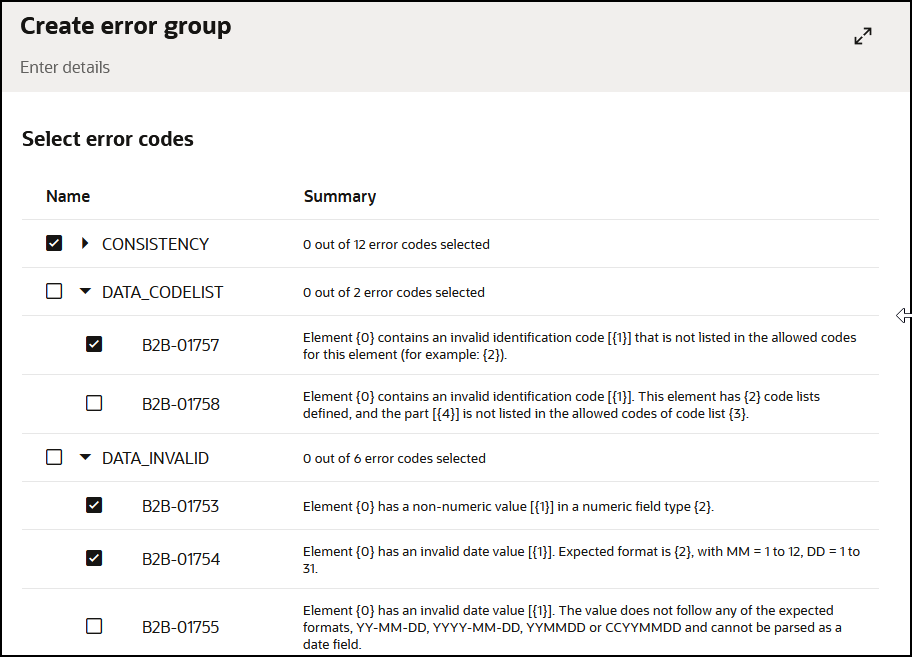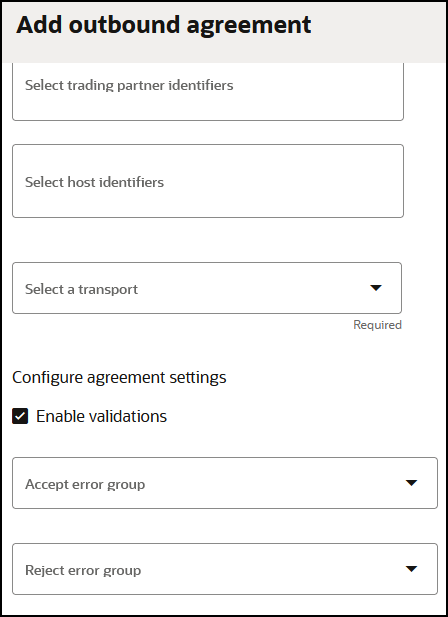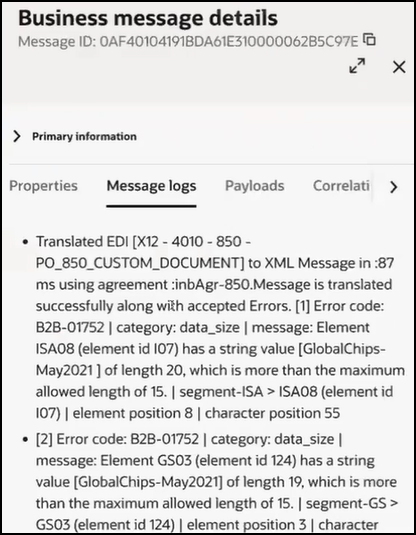Configure Error Rules for EDI Translation
You can select specific errors to ignore during EDI translation. You create a group of errors to ignore and associate that group with inbound/outbound trading partner agreements. These errors are ignored if encountered during runtime. Processing completes successfully and the errors are logged as warnings in the business messages log.
For example, assume you don't want to show any errors if a mandatory segment is missing during validation of EDI translation. You can create an error group at the trading partner level in which you select the error codes to ignore that are related to the missing segment. EDI translation is successfully validated and no errors occur.
Capabilities
- The error group only impacts the X12, X12 HIPPA, and EDIFACT documents.
- You can select all errors or specific errors from the following categories
to ignore during EDI translation.
- Consistency
- Data code list
- Data invalid
- Data size
- Extra data
- Fatal errors
- Information
- Miscellaneous
- Structural
- You associate the error group with inbound and outbound trading partner
agreements. During configuration, the error group you created is displayed for selection
in two lists:
- Accepted list: When an error group selected from the accepted list is associated with an agreement, and the errors occur during translation processing, the errors are ignored with warnings (mentioning what error occurred and specifying the error code and error details) and translation passes successfully.
- Rejected list: When an error group selected from the rejected list is associated with an agreement, and the errors occur during translation processing, the errors are considered fatal, translation is rejected, and the error code and details are specified.
- The accepted list contents takes precedence over the rejected list contents. If the same error code is associated with the accept and reject lists, the accept list takes precedence and translation is successful even when that error occurs.
- The error group is honored at runtime when the trading partner agreement is deployed.
- If the error group is modified, the trading partner agreement must be redeployed.
- The error group cannot be deleted if it is part of a trading partner agreement. This is regardless of whether the agreement is deployed.
Create and Associate an Error Group with a Trading Partner Agreement
- To configure error rules in a project:
- In the navigation pane, click Projects.
- Click the project in which to configure error rules.
- Click B2B
 .
.
- In the Trading partners section, click the trading partner in which to configure error rules.
- To configure error rules in a standalone environment:
- In the navigation pane, click B2B, then Trading partners.
- In the row of the trading partner for which to configure error rules,
click Edit
 .
.
- Click Error groups.
- Click Add
 .
.
The Create error group panel is displayed.
- Enter a name and optional description.
- Select the errors to ignore during EDI validation at runtime.
- Select a category to ignore all errors in that category.
- Expand a category, then select the individual errors in that category to ignore.
For example:

- Click Create.
- Click Transports & Agreements.
- For an inbound and/or outbound agreement, click Add
 .
.
- Under Configure agreement settings, select the
Enable validations check box. The two lists show the error groups
you created under the Error groups tab. You can select up to one
error group from each list.
- Accept error group
- Reject error group
For a description of these lists, see Capabilities.
- Select the error group to ignore during EDI validation at runtime.

- Deploy the agreements and run the integration.
The activity stream shows that processing completed successfully because any errors in the error group that were encountered were ignored.
- In the navigation pane, click Observability, then B2B tracking.
- Click Business messages.
- View the business message details for this message. The errors you defined in
the error group are listed and were ignored during EDI validation. Translation was
successful.

See Create Agreements.